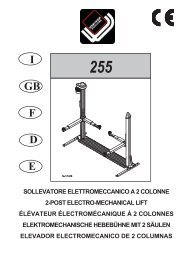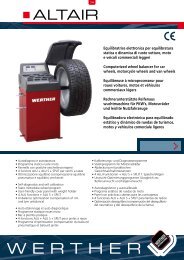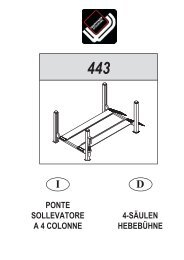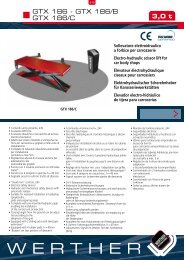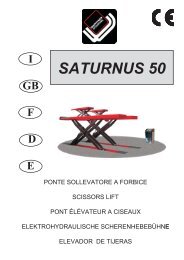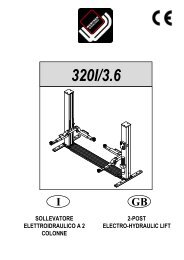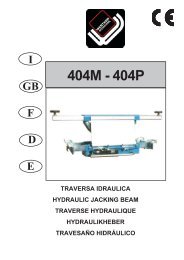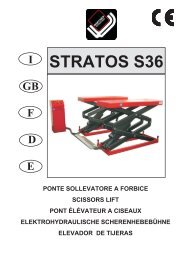IAttenzione - Wertherint.de
IAttenzione - Wertherint.de
IAttenzione - Wertherint.de
Create successful ePaper yourself
Turn your PDF publications into a flip-book with our unique Google optimized e-Paper software.
RISQUES DIRECTS AUX PERSONNESDans ce paragraphe sont illustrés les risques que l’opérateur, l’agentd’entretien et toute personne présente dans l’aire <strong>de</strong> travail peuvent encourirà cause d’une mauvaise utilisation <strong>de</strong> l’élévateur.GEFAHREN FÜR PERSONENIn diesem Paragraph wird auf die Gefahren eingegangen, <strong>de</strong>nen <strong>de</strong>rBediener, <strong>de</strong>r Wartungsfachmann und an<strong>de</strong>re Personen bei einemnicht korrekten Betrieb <strong>de</strong>r Hebebühne ausgesetzt sind, wenn sie sichim Wirkungsbereich <strong>de</strong>r Hebebühne aufhalten.RIESGOS DIRECTOS A LAS PERSONASEn este apartado se ilustran los riesgos que el operario, personal <strong>de</strong>servicio y todo el que se encuentre en el área <strong>de</strong> trabajo <strong>de</strong>l elevador,pue<strong>de</strong>n correr a consecuencia <strong>de</strong> un uso no correcto <strong>de</strong>l mismo elevador.RISQUE D’ÉCRASEMENT DE L’OPÉRATEURdû à une mauvaise position <strong>de</strong> celui-ci lorsqu’il actionne les comman<strong>de</strong>s<strong>de</strong> l’élévateur. Durant la phase <strong>de</strong> <strong>de</strong>scente <strong>de</strong> l’élévateur et du véhicule,l’opérateur ne doit jamais se placer sous les parties en mouvementmais opérer toujours <strong>de</strong>puis la zone <strong>de</strong> comman<strong>de</strong> (fig. 18).QUETSCHGEFAHR FÜR DEN BEDIENERBeruht auf einer falschen Position <strong>de</strong>s Bedieners <strong>de</strong>r Steuertafel.Während <strong>de</strong>s Abstiegs <strong>de</strong>r Trittbretter und <strong>de</strong>s Fahrzeugs darf sich <strong>de</strong>rBediener niemals unter die absteigen<strong>de</strong>n Teile begeben, son<strong>de</strong>rn mußsich immer im Steuerbereich aufhalten (Abb. 18).RIESGO DE APLASTAMENTO DEL OPERARIOa consecuencia <strong>de</strong> una colocación errónea <strong>de</strong>l operario manejando elcuadro <strong>de</strong> mandos.Durante la fase <strong>de</strong> bajada <strong>de</strong> los brazos y <strong>de</strong>l vehículo el operario no<strong>de</strong>be colocarse nunca <strong>de</strong>bajo <strong>de</strong> las partes móviles, y por lo tanto trabajar<strong>de</strong>s<strong>de</strong> la zona <strong>de</strong> mando (fig.18).RISQUE D’ÉCRASEMENT DU PERSONNEL EN GÉNÉRALDurant la phase <strong>de</strong> <strong>de</strong>scente <strong>de</strong> l’élévateur et du véhicule, le personnelne doit pas rester dans la zone concernée par la trajectoire <strong>de</strong> <strong>de</strong>scente(fig. 19). L’opérateur doit s’assurer avant toute manoeuvre, qu’aucunepersonne ne soit en positon dangereuse.QUETSCHGEFAHR FÜR DAS PERSONAL IM ALLGEMEINENWährend <strong>de</strong>s Abstiegs <strong>de</strong>r Hebebühne und <strong>de</strong>s Fahrzeugs darf sichdas Personal nicht im Wirkungskreis <strong>de</strong>r Hebebühne aufhalten (Abb.19). Der Bediener darf die Hebebühne erst dann manövrieren, wenn ersich überzeugt hat, daß sich keine Personen im Gefahrbereich aufhält.RIESGO DE APLASTAMENTO DE LAS PERSONAS EN GENERALDurante la fase <strong>de</strong> bajada <strong>de</strong>l elevador y <strong>de</strong>l vehículo las personas no<strong>de</strong>ben permanecer en la zona <strong>de</strong> la trayectoria <strong>de</strong> bajada (fig. 19).El operario <strong>de</strong>be maniobrar solo <strong>de</strong>spués <strong>de</strong> haberse cerciorado queno hay ninguna persona en situación peligrosa.RISQUE DE CHOCDû aux parties <strong>de</strong> l’élévateur ou du véhicule se trouvant à hauteur d’homme.Quand, pour <strong>de</strong>s raisons <strong>de</strong> travail, l’élévateur doit être arrêté à <strong>de</strong>s hauteursrelativement basses (inférieures à 1,75m du sol), il y a risque <strong>de</strong>choc contre les parties non repérées par une couleur spécifique. (fig.20).STOSSGEFAHRBeruht auf <strong>de</strong>n Teilen <strong>de</strong>r Hebebühne und <strong>de</strong>s Fahrzeugs, die sich inKopfhöhe befin<strong>de</strong>n.Wenn die Hebebühne für Arbeiten in ziemlich niedriger Position angehaltenwird (Bo<strong>de</strong>nabstand unter 1,75 m) besteht die Gefahr gegennicht durch beson<strong>de</strong>re Farben gekennzeichnete Teile zu stossen (Abb.20).RIESGO DE GOLPECausado por las partes <strong>de</strong>l elevador e <strong>de</strong>l vehículo colocado a la altura<strong>de</strong> una persona.Cuando, por razones <strong>de</strong> trabajo, el elevador se encuentra parado a unaaltura relativamente baja (inferior a 1,75 m. <strong>de</strong>s<strong>de</strong> el suelo) existe el riesgo<strong>de</strong> golpearse contra las partes que no están marcadas con los coloresparticulares (fig. 20).RISQUE DE DÉPLACEMENT DU VÉHICULEDû à <strong>de</strong>s opérations <strong>de</strong> travail qui engendrent <strong>de</strong>s poussées sur le véhicule(fig. 21).Si le véhicule est <strong>de</strong> poids et <strong>de</strong> dimensions respectables, un déplacementpeut représenter une surcharge ou un déséquilibre non prévu.Éviter donc <strong>de</strong> manière absolue ce type <strong>de</strong> manoeuvre.GEFAHR DURCH EINE VERSCHIEBUNG DES FAHRZEUGSBeruht auf Eingriffen, die einen Schub auf das Fahrzeug ausüben (Abb.21).Wenn das Fahrzeug ziemlich groß o<strong>de</strong>r schwer ist, kann eine Verschiebung<strong>de</strong>sselbens zu einer nicht vorhersehbaren Überbelastung o<strong>de</strong>rungleichmäßigen Gewichtverteilung führen. Daher sind <strong>de</strong>rartige Manöverunbedingt zu vermei<strong>de</strong>n.RIESGO DE MOVIMIENTO DEL VEHÍCULOCausado durante las operaciones que precisan <strong>de</strong> impulsos sobre elvehículo (fig. 21).Si el vehículo es <strong>de</strong> dimensiones y peso consi<strong>de</strong>rables un movimientopue<strong>de</strong> representar una situación <strong>de</strong> sobrecarga o balanceo imprevistos;por lo tanto hay que evitar absolutamente tales maniobras.27




